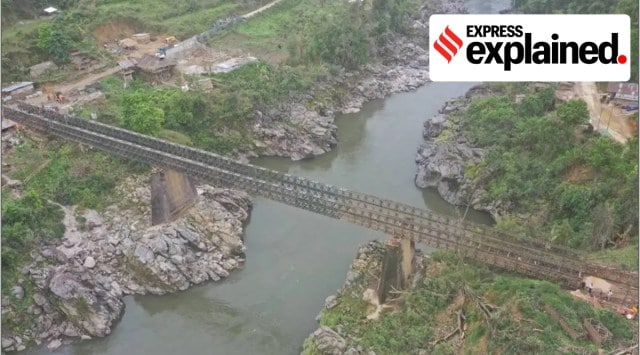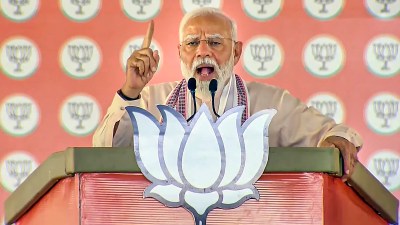- India
- International
A strategy of assertion: Why China is inventing names for places in Arunachal Pradesh
China claims some 90,000 sq km of Arunachal Pradesh as its territory. It calls the area “Zangnan” in the Chinese language and makes repeated references to “South Tibet”.
 The new Daporijo bridge, completed by BRO in Arunachal Pradesh. (Express photo)
The new Daporijo bridge, completed by BRO in Arunachal Pradesh. (Express photo)China’s Ministry of Civil Affairs announced on Wednesday (December 29) that it had “standardised” the names of 15 places in Arunachal Pradesh, acting in accordance with regulations on geographical names issued by the State Council, the equivalent of the Chinese Cabinet.
The Ministry of External Affairs has dismissed the Chinese “invention”. In a statement, the official spokesperson of the ministry said, “Arunachal Pradesh has always been, and will always be, an integral part of India. Assigning invented names to places in Arunachal Pradesh does not alter this fact.”
Why is China giving names to places that are in India?
China claims some 90,000 sq km of Arunachal Pradesh as its territory. It calls the area “Zangnan” in the Chinese language and makes repeated references to “South Tibet”. Chinese maps show Arunachal Pradesh as part of China, and sometimes parenthetically refer to it as “so-called Arunachal Pradesh”.
China makes periodic efforts to underline this unilateral claim to Indian territory. Giving Chinese names to places in Arunachal Pradesh is part of that effort.
So has it done something like this earlier too?

Yes. This is a second lot of “standardised” names of places in Arunachal Pradesh that China has announced. On April 14, 2017, its Ministry of Civil Affairs had issued “official” Chinese names for six places in the state. It had said at the time that it was releasing a “first batch” of “standardised” names.
“According to relevant regulations on the management of place names, the department has standardised some place names in China’s South Tibet region. We have released the first batch of the place names in South Tibet (six in total),” the Chinese government had said.
The six names on that list then, written in the Roman alphabet, were “Wo’gyainling”, “Mila Ri”, “Qoidengarbo Ri”, “Mainquka”, “Bumo La” and “Namkapub Ri”.
The latitude and longitude listed with the names showed those places as Tawang, Kra Daadi, West Siang, Siang (where Mechuka or Menchuka is an emerging tourist destination), Anjaw, and Subansiri respectively.
These six places spanned the breadth of Arunachal Pradesh — “Wo’gyainling” in the west, “Bumo La” in the east and the other four located in the central part of the state.
Newsletter | Click to get the day’s best explainers in your inbox
Four and a half years later, the Chinese have renamed eight residential areas, four mountains, two rivers, and a mountain pass, according to the state-run Global Times. This time too, it has provided the latitudes and longitudes of these places.
But what is China’s argument for claiming these areas?
The People’s Republic of China disputes the legal status of the McMahon Line, the boundary between Tibet and British India that was agreed at the Simla Convention — officially the ‘Convention Between Great Britain, China, and Tibet’ — of 1914.
China was represented at the Simla Convention by a plenipotentiary of the Republic of China, which had been declared in 1912 after the Qing dynasty was overthrown. (The present communist government came to power only in 1949, when the People’s Republic was proclaimed.) The Chinese representative did not consent to the Simla Convention, saying Tibet had no independent authority to enter into international agreements.
The McMohan Line, named after Henry McMahon, the chief British negotiator at Shimla, was drawn from the eastern border of Bhutan to the Isu Razi pass on the China-Myanmar border. China claims territory to the south of the McMahon Line, lying in Arunachal Pradesh.
China also bases its claims on the historical ties that have existed between the monasteries in Tawang and Lhasa.
In 2017, Lu Kang, then spokesperson of the Chinese Ministry of Foreign Affairs, had said: “China has a coherent and clear standpoint of the border between China and India. It is proper action to announce those Chinese place names to the public, as it is according to regulations established by the State Council.”
What does China seek to gain from making these claims?
As stated earlier, it is a part of the Chinese strategy to assert its territorial claims over Indian territory. As part of this strategy, China routinely issues statements of outrage whenever an Indian dignitary visits Arunachal Pradesh — it did so most recently when Vice President Venkaiah Naidu went there to address the state Assembly in October.
Beijing keeps harping on its “consistent” and “clear” position that the Indian possession of Arunachal Pradesh, though firmly established and recognised by the world, is “illegal”, and asks New Delhi to stop taking actions to “complicate” the border issue.
The “first batch” of renamings in 2017 had come days after the Dalai Lama visited Arunachal Pradesh, against which Beijing had lodged a strong protest. Spokesperson Lu had, however, claimed that the “standardisation” was necessary since all names used in “southern Tibet” were inherited through word-of-mouth for generations by minority ethic groups.
“These names reflect and indicate from one aspect, that China’s proposal on the sovereignty claim of South Tibet region has a prominent historical, cultural, administrative and jurisdictional basis,” Lu had said.
Speaking to The Indian Express at the time, Wang Dehua, then director of the Institute for South and Central Asia Studies in Shanghai, had claimed that through this move, China wanted to prove its territorial jurisdiction over Arunachal Pradesh.
“The changing of names is an ongoing process in China. Just like how Bombay was changed to Mumbai or Madras was changed to Chennai in India. It just so happens that the names standardised are in southern Tibet,” Wang had said.
Laying aggressive claims to territories on the basis of alleged historical injustices done to China is a part of Beijing’s foreign policy playbook.
The claim on Taiwan is one such example, as are the consistent efforts to change the “facts on the ground” in several disputed islands in the South China Sea. The aggression is at all times backed in overt and covert ways by the use of China’s economic and military muscle.
Will the new border law adopted by China complicate the situation along the India-China border?
China’s national legislature – the National People’s Congress (NPC) – on October 23 adopted a new law on the protection and exploitation of the land border areas which drew sharp reaction from India as it was passed amid a protracted military standoff between the two sides in eastern Ladakh region.
On the same day, President Xi Jinping signed a decree No. 99 on the same day announcing that the law will come into effect from January 1, 2022.
China said its new land border law will not impact the implementation of the existing border treaties and urged relevant countries to avoid making “wanton speculation” about a “normal domestic legislation”, a day after India raised concerns over the legislation.
Reacting to the new law, External Affairs Ministry spokesperson said that India expects that China will avoid undertaking action on the pretext of new border law, which could unilaterally alter the situation in the India-China border areas.
“Such unilateral move will have no bearing on the arrangements that both sides have already reached earlier, whether it is on the boundary question or for maintaining peace and tranquillity along the LAC in India-China border areas,” saikd MEA spokesperson Arindam Bagchi.
Over the years, India and China have worked out a host of agreements to resolve and handle the border differences. These include the Special Representatives mechanism, the Agreement on Political Parameters and Guiding Principles of 2005, the WMCC (Working Mechanism for Consultation and Coordination on India-China Border Affairs) besides protocols and CBMs to ensure peace and tranquility along the LAC.
Both the countries have already held 22 rounds of border talks under the framework of the Special Representatives dialogue, which was set up to find an early solution to the border dispute.
India and China have also been maintaining that pending the final resolution of the boundary issue, it is necessary to maintain peace and tranquility in the border areas.
However, China promulgated the new land boundary law in the midst of a 17-month border standoff between the two countries in eastern Ladakh. The eastern Ladakh border standoff between the Indian and Chinese militaries erupted on May 5 last year following a violent clash in the Pangong lake areas and both sides gradually enhanced their deployment by rushing in tens of thousands of soldiers as well as heavy weaponry. The tension escalated following a deadly clash in Galwan Valley on June 15 last year.
As a result of a series of military and diplomatic talks, the two sides completed the disengagement process in the north and south banks of the Pangong lake in February and in the Gogra area in August.
More Explained
EXPRESS OPINION
Apr 25: Latest News
- 01
- 02
- 03
- 04
- 05











































